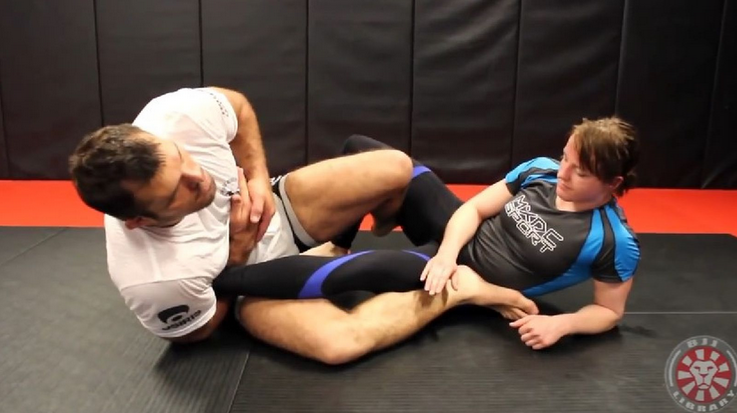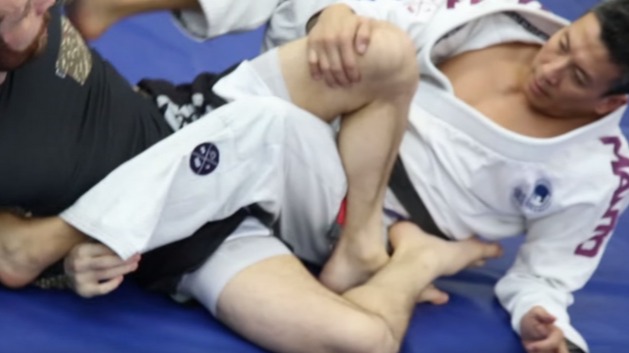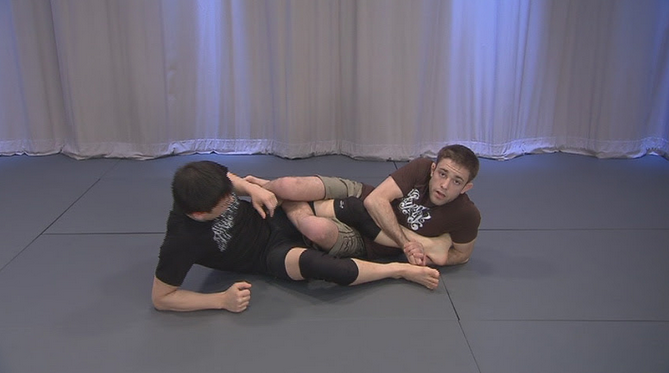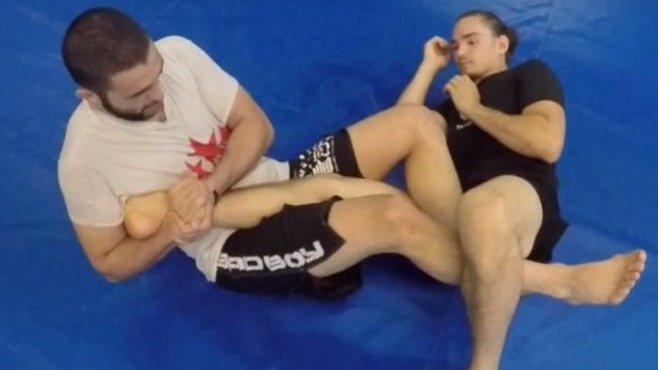Technique Feature: Leg Locks Decoded
Technique Feature: Leg Locks Decoded
By T.P. Grant The jiu-jitsu scene is nothing if not trendy. A technique, position, or athlete will become the hot, new thing and grapplers, both professional and hobbyist, will look to replicate that success. It will be the talk of the jiu-jitsu world, an

0:00 / 1:18
- Auto
- 1080
- 720
- 480
- 360
- 240
- 224
By T.P. Grant
The jiu-jitsu scene is nothing if not trendy. A technique, position, or athlete will become the hot, new thing and grapplers, both professional and hobbyist, will look to replicate that success. It will be the talk of the jiu-jitsu world, and then often it will integrated into the metagame and it is on to the next trend. There is no shortage of examples: the deep half guard, the 50/50 guard, the berimbolo, the leg drag, and more recently lapel guards.
Currently leg locks are the in thing in the jiu-jitsu world, and there a few reasons behind this. First and foremost, the rule sets of competitions are changing, there are real alternatives to the IBJJF rule set that open the leg lock game and make it a much more viable option.
But is it really a trend? There have always been really good leg lockers out there, many of them hailing from other arts but rule sets have historically kept them out of jiu-jitsu competitions. Historically the great leg lockers kept to submission grappling competitions like ADCCs or have competed in MMA but, now some jiu-jitsu competitions have become more accessible to them. Also many of the guards and positions that became popular in the more restricted rule sets are very vulnerable to leg locks as they involved sitting back and extending legs into the air, such as the Spider Guard or De La Riva Guard. For some competitors it is a far more efficient use of energy to attack these guards with leg locks rather than attempt to pass them. And then there is the double guard pull positions, which has already lent itself to a good deal of leg locking even within the IBJJF rule set.
This a real positive for the jiu-jitsu community as leg locks have long been something of a blind spot for large sections of the jiu-jitsu world and leg locks catching on will likely have a long term effect of making them far less taboo down the road.
As more jiu-jitsu players seek to learn leg locks one of the most important aspects isn t just the submission itself, but the positioning on the way to finding that submission. Controlling a leg to expose it for a leg lock is a position unto itself, and doing so without exposing yourself to counter leg attacks can be very tricky.
So this article will seek to cover some of the basics of leg positioning when seeking to start attacking an ankle lock or heel hook, which forms a foundation on which to build a leg lock game. These positions have long histories with many names, some very recent names, have been applied to them, so to cut through the nomenclature confusion this will be a general overview of five key positions. But this is by no means a complete accounting of leg lock positions, it is a deeply technical and nuanced game that could not possibly all be covered in one reading.
==
The Single Leg X (aka Ashi Garami)

Here is a still of Dean Lister demonstrating the position from his video on the BJJ Library YouTube channel. Dean is attacking the left leg of his training partner and has his right foot on the outside driving into her hip, which allows Lister to push her away creating tension for the lock. Lister s left leg is between his training partner s legs and from there he can squeeze his knees together to get excellent control of her left leg, or Lister can use it hamper her movement by hooking it to her right leg, as he is in the image. The position of the leg being attack can be as pictured above or across Lister s body.
From here is where the web of footlock possibilities springs from, it is a position that is noteworthy for its versatility and adaptability. Lister s feet are not connected, locked, or in any way hampered from moving, if the need arises he can quickly transition his feet to inside or outside positions with little difficulty, he could disengage entirely and come up to a top position, if his partner were to stand without readjusting his feet he would be in the Single Leg X Guard, made famous by Marcelo Garcia, and work a sweep game.
They keys for maintaining this position is a constant, digging pressure from that foot in the hip, tight control of her lower leg with Lister s arms, and the ability to rotate with any attempt to turn. It doesn t provide the highest level of control, this position provides decent protection for counter attacks.
Since this position is a foundation for developing a leg lock game here is the full Dean Lister video where he delves into the details of the position, grips, and tips for finishing the straight ankle lock.
Outside Lockups
An outside lockup occurs when the attacker places both his feet outside the defender s legs. This can provide better control than the Single Leg X position, but leaves the feet open for counter leg locks, so careful placement is a must. Traditionally speaking outside lock ups and the single leg X position have been favored by jiu-jitsu players because they are legal in all jiu-jitsu rule sets.
Outside Ashi Garami

The Outside Ashi Garami is similar to the regular Ashi Garami, but in the still above from the BJJ Hacks piece on Eddie Cummings you can see that both Eddie s feet are outside of his training partner s legs. Also notice the leg being attacked not across Cummings body. From this position Cummings has good control of the leg he is attacking and can expose it for an ankle lock or a traditional heel hook, it also provides an easy transition into a toe hold and kneebar attack. It is relatively an easy position to achieve, however it does leave Cummings feet slightly more vulnerable, so keeping his heels pinched tightly into the opponent s hip is a must.
The 50/50

Above is a still of Ryan Hall from his 50/50 Guard instructional, one of the best instructional videos for the position. The name comes for the equal nature of the position. Above you can see Ryan Hall with his friend and training partner Seph Smith in the 50/50 position, Hall s legs are locked up on the outside of Smith s left leg, same as the Outside Ashi position, but the key difference is that Seph s left leg is passed across Hall s body. Both Hall s and Smith s left legs are in the same position, across the body, thus the name 50/50, both grapplers have all the offensive and defensive options. The inverted heel hook is available from the position, which is what Hall is attacking in the still, and it is an extremely powerful and efficient joint lock. In addition to that straight ankle locks, toe holds, and leg weave locks are in play in this position for both grapplers. It can be a powerful position, but one must very defensively savvy while working for leg locks because the risk of counter attack can be very high.
Inside Lockups
An inside lockup occurs when the offensive grappler places both his fight inside the legs of his opponent. This is generally a superior leg position as inside lock ups provide superior control and largely eliminate the threat of counter leg locks. Generally speaking they are hard to attain against savvy grapplers, who jealously guard against to deny their opponents the advantages the positions afford. Again generally speaking the inside lock ups tend to be favored by grapplers hail from the non-traditional Brazilian Jiu-Jitsu backgrounds: from Sambo, Catch Wrestling, Luta Livre, or 10th Planet. This is largely due to inside lock ups being illegal in many jiu-jitsu competitions, but this is changing and there is a new generation of jiu-jitsu grapplers who make heavy use of inside lock ups. There are many inside lock ups, here are a few of the most used with their most common names.
Inside Sankaku (aka the 4-11, aka the Honey Hole, aka the Saddle, aka Top Rock)

This position has many names, mainly because it is an devastatingly efficient position to leg lock from. Above is famed MMA coach and Renzo Gracie black belt Firas Zahabi teaching the position on his outstanding YouTube Channel. Like the 50/50, Firas has his opponent s leg across his body in position for an inverted heel hook, but Firas left leg comes over the leg he is attacking and hooks under the outside leg. Firas right leg is also hooking under the outside leg, the legs can be triangled or simply hooked under the legs.
This position provides the offensive benefits of the 50/50 guard but provides very little in the way of chances to counter attack. The primary attack from here is the inverted heel hook but the finish can be tricky, if Firas goes to rip the lock across his body he is actually aiding the escape because there is nothing stopping his training partner from kicking his free leg over and turning with the heel hook.
Here is the full video of Firas teaching the inverted heel hook and the "Inside Sankaku" position, he nicely breaks down the finer details of the position and finish.
The Leg Knot (aka Game Over)

The dreaded leg knot position, here demonstrated by American Sambist Reilly Bodycomb from his run of YouTube Leg Knot instructionals on the TakingItToTheMMAT. Reilly s left leg comes over his opponent s right leg and then dives it under his opponent's left leg. Reilly s right leg is hooked over the shin of his opponent s left leg, and Reilly has crossed his ankles. From here Reilly has utter control of both his opponent's legs while being able to have a hand free.
This is an utterly dominant position for Bodycomb, he can attack for heel hooks, toe holds, ankle locks, and hip locks. His opponent has no options other than to attempt to untie the leg knot, which is difficult to do before the leg lock is finished. It is a difficult position to achieve and requires a great deal of finesse to achieve.
==
Finding Resources
It bears restating none of these positions are new, many of them are quite old and have been used in various grappling styles that pre-date Brazilian Jiu-Jitsu. That isn t to say there isn t legitimate evolution occurring, as the submission grappling community continues to go and share information evolution is the natural result.
There are plenty of resources for people interested learning leg locks and leg positioning. All the people mentioned in the article here would be fantastic places to start as Dean Lister, Eddie Cummings, Ryan Hall, Firas Zahabi, and Reilly Bodycomb all teach seminars and classes at their respective academies and learning in person always preferable. Following them on social media is a good start as they will often put out videos
Dean Lister has countless instructionals, though one of his most recent is through the BJJ Library. Roli Delgado, former UFC fighter and coach of Hillary Williams, has put out some fantastic material on IBJJF legal leg locks. Erik Paulson s CSW school produces a great deal of material as well.
From the Sambo community Reilly Bodycomb's No Kurtka series, specifically Volume 2, is one of the more complete instructions on leg locks and his Top Rock video is a fantastic seminar on a set of entries. Stephen Koefper has put out excellent material on YouTube and covers a great number of inside lock ups, and Vladislav Koulikov has also released some excellent work.
Keep exploring leg locks and hopefully this trend becomes a pillar of the jiu-jitsu community alongside the other joint locks.
Additionally, FloPRO has an extensive library of BJJ technique videos feature stars of the sport so be sure to check back here for more.
The jiu-jitsu scene is nothing if not trendy. A technique, position, or athlete will become the hot, new thing and grapplers, both professional and hobbyist, will look to replicate that success. It will be the talk of the jiu-jitsu world, and then often it will integrated into the metagame and it is on to the next trend. There is no shortage of examples: the deep half guard, the 50/50 guard, the berimbolo, the leg drag, and more recently lapel guards.
Currently leg locks are the in thing in the jiu-jitsu world, and there a few reasons behind this. First and foremost, the rule sets of competitions are changing, there are real alternatives to the IBJJF rule set that open the leg lock game and make it a much more viable option.
But is it really a trend? There have always been really good leg lockers out there, many of them hailing from other arts but rule sets have historically kept them out of jiu-jitsu competitions. Historically the great leg lockers kept to submission grappling competitions like ADCCs or have competed in MMA but, now some jiu-jitsu competitions have become more accessible to them. Also many of the guards and positions that became popular in the more restricted rule sets are very vulnerable to leg locks as they involved sitting back and extending legs into the air, such as the Spider Guard or De La Riva Guard. For some competitors it is a far more efficient use of energy to attack these guards with leg locks rather than attempt to pass them. And then there is the double guard pull positions, which has already lent itself to a good deal of leg locking even within the IBJJF rule set.
This a real positive for the jiu-jitsu community as leg locks have long been something of a blind spot for large sections of the jiu-jitsu world and leg locks catching on will likely have a long term effect of making them far less taboo down the road.
As more jiu-jitsu players seek to learn leg locks one of the most important aspects isn t just the submission itself, but the positioning on the way to finding that submission. Controlling a leg to expose it for a leg lock is a position unto itself, and doing so without exposing yourself to counter leg attacks can be very tricky.
So this article will seek to cover some of the basics of leg positioning when seeking to start attacking an ankle lock or heel hook, which forms a foundation on which to build a leg lock game. These positions have long histories with many names, some very recent names, have been applied to them, so to cut through the nomenclature confusion this will be a general overview of five key positions. But this is by no means a complete accounting of leg lock positions, it is a deeply technical and nuanced game that could not possibly all be covered in one reading.
==
The Single Leg X (aka Ashi Garami)

Here is a still of Dean Lister demonstrating the position from his video on the BJJ Library YouTube channel. Dean is attacking the left leg of his training partner and has his right foot on the outside driving into her hip, which allows Lister to push her away creating tension for the lock. Lister s left leg is between his training partner s legs and from there he can squeeze his knees together to get excellent control of her left leg, or Lister can use it hamper her movement by hooking it to her right leg, as he is in the image. The position of the leg being attack can be as pictured above or across Lister s body.
From here is where the web of footlock possibilities springs from, it is a position that is noteworthy for its versatility and adaptability. Lister s feet are not connected, locked, or in any way hampered from moving, if the need arises he can quickly transition his feet to inside or outside positions with little difficulty, he could disengage entirely and come up to a top position, if his partner were to stand without readjusting his feet he would be in the Single Leg X Guard, made famous by Marcelo Garcia, and work a sweep game.
They keys for maintaining this position is a constant, digging pressure from that foot in the hip, tight control of her lower leg with Lister s arms, and the ability to rotate with any attempt to turn. It doesn t provide the highest level of control, this position provides decent protection for counter attacks.
Since this position is a foundation for developing a leg lock game here is the full Dean Lister video where he delves into the details of the position, grips, and tips for finishing the straight ankle lock.
Outside Lockups
An outside lockup occurs when the attacker places both his feet outside the defender s legs. This can provide better control than the Single Leg X position, but leaves the feet open for counter leg locks, so careful placement is a must. Traditionally speaking outside lock ups and the single leg X position have been favored by jiu-jitsu players because they are legal in all jiu-jitsu rule sets.
Outside Ashi Garami

The Outside Ashi Garami is similar to the regular Ashi Garami, but in the still above from the BJJ Hacks piece on Eddie Cummings you can see that both Eddie s feet are outside of his training partner s legs. Also notice the leg being attacked not across Cummings body. From this position Cummings has good control of the leg he is attacking and can expose it for an ankle lock or a traditional heel hook, it also provides an easy transition into a toe hold and kneebar attack. It is relatively an easy position to achieve, however it does leave Cummings feet slightly more vulnerable, so keeping his heels pinched tightly into the opponent s hip is a must.
The 50/50

Above is a still of Ryan Hall from his 50/50 Guard instructional, one of the best instructional videos for the position. The name comes for the equal nature of the position. Above you can see Ryan Hall with his friend and training partner Seph Smith in the 50/50 position, Hall s legs are locked up on the outside of Smith s left leg, same as the Outside Ashi position, but the key difference is that Seph s left leg is passed across Hall s body. Both Hall s and Smith s left legs are in the same position, across the body, thus the name 50/50, both grapplers have all the offensive and defensive options. The inverted heel hook is available from the position, which is what Hall is attacking in the still, and it is an extremely powerful and efficient joint lock. In addition to that straight ankle locks, toe holds, and leg weave locks are in play in this position for both grapplers. It can be a powerful position, but one must very defensively savvy while working for leg locks because the risk of counter attack can be very high.
Inside Lockups
An inside lockup occurs when the offensive grappler places both his fight inside the legs of his opponent. This is generally a superior leg position as inside lock ups provide superior control and largely eliminate the threat of counter leg locks. Generally speaking they are hard to attain against savvy grapplers, who jealously guard against to deny their opponents the advantages the positions afford. Again generally speaking the inside lock ups tend to be favored by grapplers hail from the non-traditional Brazilian Jiu-Jitsu backgrounds: from Sambo, Catch Wrestling, Luta Livre, or 10th Planet. This is largely due to inside lock ups being illegal in many jiu-jitsu competitions, but this is changing and there is a new generation of jiu-jitsu grapplers who make heavy use of inside lock ups. There are many inside lock ups, here are a few of the most used with their most common names.
Inside Sankaku (aka the 4-11, aka the Honey Hole, aka the Saddle, aka Top Rock)

This position has many names, mainly because it is an devastatingly efficient position to leg lock from. Above is famed MMA coach and Renzo Gracie black belt Firas Zahabi teaching the position on his outstanding YouTube Channel. Like the 50/50, Firas has his opponent s leg across his body in position for an inverted heel hook, but Firas left leg comes over the leg he is attacking and hooks under the outside leg. Firas right leg is also hooking under the outside leg, the legs can be triangled or simply hooked under the legs.
This position provides the offensive benefits of the 50/50 guard but provides very little in the way of chances to counter attack. The primary attack from here is the inverted heel hook but the finish can be tricky, if Firas goes to rip the lock across his body he is actually aiding the escape because there is nothing stopping his training partner from kicking his free leg over and turning with the heel hook.
Here is the full video of Firas teaching the inverted heel hook and the "Inside Sankaku" position, he nicely breaks down the finer details of the position and finish.
The Leg Knot (aka Game Over)

The dreaded leg knot position, here demonstrated by American Sambist Reilly Bodycomb from his run of YouTube Leg Knot instructionals on the TakingItToTheMMAT. Reilly s left leg comes over his opponent s right leg and then dives it under his opponent's left leg. Reilly s right leg is hooked over the shin of his opponent s left leg, and Reilly has crossed his ankles. From here Reilly has utter control of both his opponent's legs while being able to have a hand free.
This is an utterly dominant position for Bodycomb, he can attack for heel hooks, toe holds, ankle locks, and hip locks. His opponent has no options other than to attempt to untie the leg knot, which is difficult to do before the leg lock is finished. It is a difficult position to achieve and requires a great deal of finesse to achieve.
==
Finding Resources
It bears restating none of these positions are new, many of them are quite old and have been used in various grappling styles that pre-date Brazilian Jiu-Jitsu. That isn t to say there isn t legitimate evolution occurring, as the submission grappling community continues to go and share information evolution is the natural result.
There are plenty of resources for people interested learning leg locks and leg positioning. All the people mentioned in the article here would be fantastic places to start as Dean Lister, Eddie Cummings, Ryan Hall, Firas Zahabi, and Reilly Bodycomb all teach seminars and classes at their respective academies and learning in person always preferable. Following them on social media is a good start as they will often put out videos
Dean Lister has countless instructionals, though one of his most recent is through the BJJ Library. Roli Delgado, former UFC fighter and coach of Hillary Williams, has put out some fantastic material on IBJJF legal leg locks. Erik Paulson s CSW school produces a great deal of material as well.
From the Sambo community Reilly Bodycomb's No Kurtka series, specifically Volume 2, is one of the more complete instructions on leg locks and his Top Rock video is a fantastic seminar on a set of entries. Stephen Koefper has put out excellent material on YouTube and covers a great number of inside lock ups, and Vladislav Koulikov has also released some excellent work.
Keep exploring leg locks and hopefully this trend becomes a pillar of the jiu-jitsu community alongside the other joint locks.
Additionally, FloPRO has an extensive library of BJJ technique videos feature stars of the sport so be sure to check back here for more.